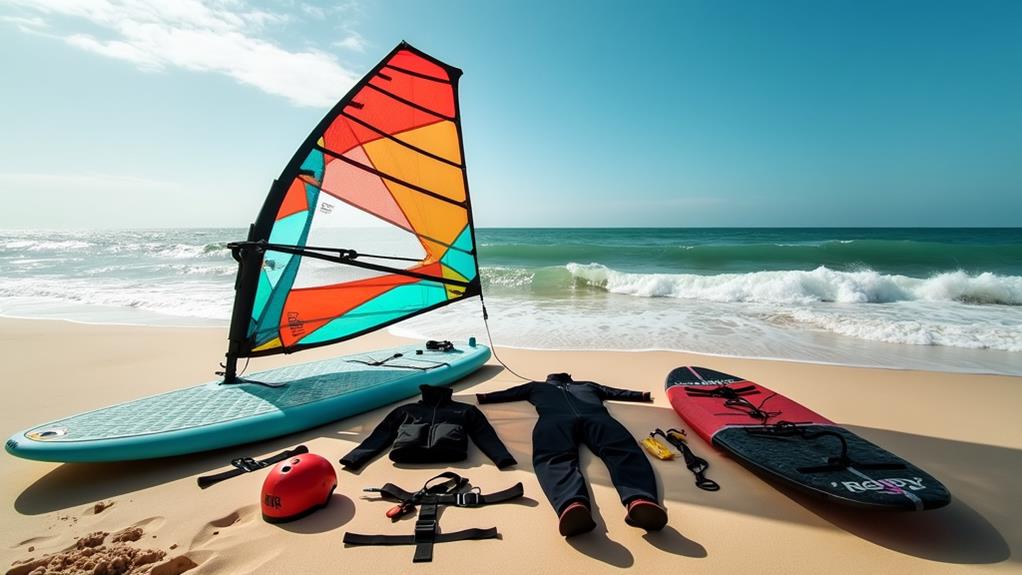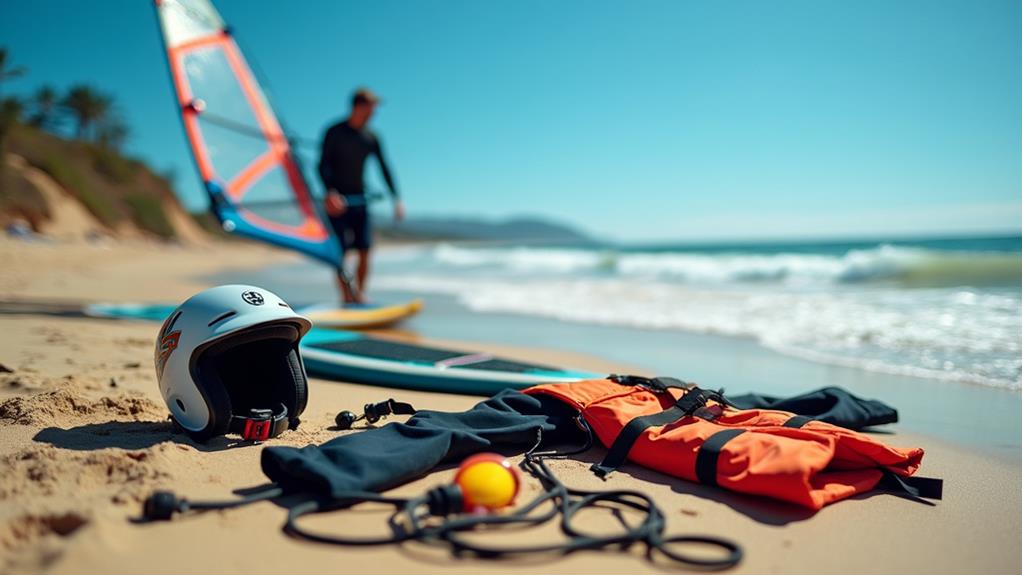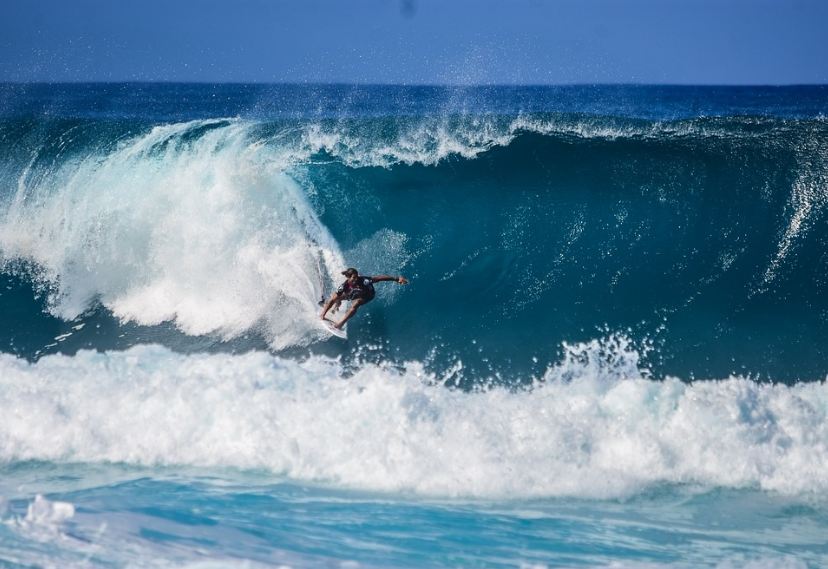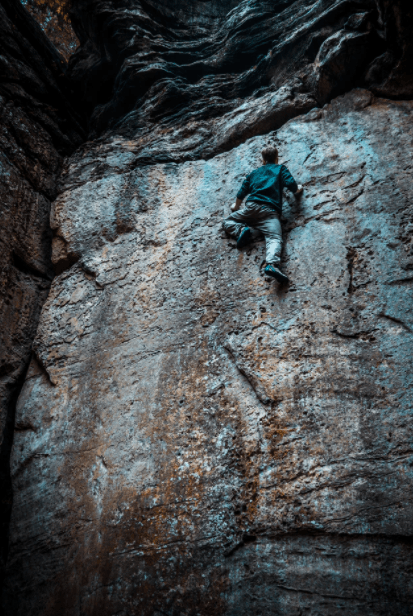What Equipment Is Needed for Windsurfing?

When starting windsurfing, you'll need a few key pieces of equipment to ensure a safe and enjoyable experience. First, a stable windsurfing board, like the Tahe Beach 225D, provides the foundation. Then, you'll need a rig, which includes a sail, mast, boom, mast extension, and Universal Joint. Sails between 4.0m² to 5.5m² are ideal for beginners. Don't forget safety gear, such as a USCG-approved life jacket and helmet. Appropriate attire, like windsurfing boots and layered clothing, also plays a significant role. Choosing the right gear is vital for both safety and performance.
Windsurfing Board
Choosing the right windsurfing board significantly impacts your overall experience, especially for beginners. For those starting out, it's crucial to select a board that offers stability and ease of use. Beginner boards should be at least 75 cm wide and have a volume of around 180 liters. This ensures a stable platform, making it easier to stand and maneuver without tipping over.
Stability is essential for beginners, and wider boards (at least 70 cm) provide the steady platform needed. Many beginner boards also feature a daggerboard or center fin, which aids in tracking and upwind sailing, enhancing control and balance.
The length of the board also plays a role. Longer boards glide more smoothly, particularly in light winds, offering a more enjoyable ride. Models like the Tahe Beach 225D and Starboard Rio are highly recommended for beginners due to their design focused on ease of use and stability.
Fin and Footstraps
The fin and footstraps on your windsurfing board are crucial for optimal sailing performance. The fin ensures direction and stability, while footstraps connect your feet to the board for better control and the ability to execute jumps. Selecting the right fin and footstraps is particularly important for beginners to enhance their sailing experience.
Here's what you need to know:
- Fin Types: Common types include US Box, Powerbox, Tuttle, and Deep Tuttle. Each type affects performance and must be compatible with your board.
- Fin Size: Larger fins provide better stability and are ideal for beginners. Advanced sailors may prefer smaller fins for increased maneuverability and speed.
- Footstrap Fit: Ensure your footstraps fit securely and comfortably. Proper fit boosts confidence and performance on the water.
- Maintenance: Regularly inspect your fins and footstraps for damage or wear. Proper maintenance is essential for safety and enjoyment.
Windsurfing Rig

After ensuring your fin and footstraps are in prime shape, let's focus on the windsurfing rig—the powerhouse of your setup. The windsurfing rig comprises the sail, mast, boom, mast extension, and Universal Joint (UJ). Each component works together to harness wind power and propel you forward.
The sail, typically made from monofilm or dacron, is essential. For beginners, a sail size between 4.0m² and 5.5m² is suitable due to its ease of handling. The mast, usually in two sections, provides structural support for the sail. Beginners should consider a mast with 40% carbon, which offers a balanced compromise between weight and cost. Masts typically vary in length by 30cm intervals.
The boom is crucial for maintaining the sail's shape and is adjustable for height, enhancing your steering and control. The mast extension allows for the use of non-standard mast lengths. The Universal Joint (UJ) connects the sail to the board and should be checked regularly for wear, as its rubber component can degrade over time.
Here's a quick overview:
| Component | Function | Material/Type |
|---|---|---|
| Sail | Harnesses wind power | Monofilm, Dacron |
| Mast | Provides structural support | 40% Carbon |
| Boom | Maintains sail shape, adjustable | Aluminum, Carbon |
Ensuring these components are in peak condition will make your windsurfing experience smooth and enjoyable.
Sail Characteristics
Understanding sail characteristics is essential for enhancing your windsurfing experience. When selecting a sail, you need to consider multiple elements to ensure it meets your needs, especially if you're new to the sport.
First, focus on sail size. For beginner windsurfing, sails typically range from 4.0m² to 5.5m². Smaller sails are easier to handle and control, particularly useful in light wind conditions where managing larger sails can be cumbersome.
Next, contemplate the sail shape and materials. Most sails are made from durable materials like monofilm and dacron, balancing lightweight performance and durability, which is perfect for beginners tackling different conditions.
Another significant factor is the luff length, the vertical length from the bottom to the top of the sail. It's vital for compatibility with your mast and directly affects the sail's performance.
Here's what to look for:
- Size: Start with 4.0m² to 5.5m².
- Material: Opt for monofilm or dacron.
- Luff Length: Ensure it matches your mast.
- Avoid Camber Inducers: These complicate rigging and handling.
Safety Gear

Choosing the right sail is crucial, but ensuring you have the proper safety gear is paramount for a secure and enjoyable windsurfing experience. A USCG Approved Life Jacket is essential for all participants, providing buoyancy and preventing drowning. It is a critical piece of equipment that ensures you stay afloat, particularly in rough waters.
A helmet is another vital item, recommended for all skill levels. It protects your head from injuries during falls or collisions. Ensure it fits securely to offer maximum protection.
Wetsuits are indispensable for thermal insulation, keeping your body warm in cold water. Depending on the season, you might choose a 5mm wetsuit for winter or a 3mm or shorty wetsuit for summer. This ensures you maintain body warmth and can enjoy longer sessions without discomfort.
For beginners, buoyancy aids are highly recommended. They provide flotation without restricting your movements, allowing you to focus on mastering the basics. While they offer less head protection than traditional life jackets, they are excellent for learning.
Appropriate Attire
For windsurfing, you'll need essential clothing and protective gear for both comfort and safety. A wetsuit is critical for thermal insulation: opt for a 5mm thickness in winter and a 3mm or shorty for summer conditions. Windsurfing boots provide necessary grip, while a USCG-approved life jacket ensures buoyancy. Additionally, a snug-fitting helmet is crucial for head protection.
Essential Windsurfing Clothing
Choosing the right clothing for windsurfing is essential for ensuring safety, comfort, and optimal performance on the water. The most critical piece is a wetsuit, which provides thermal insulation. Wetsuit thickness varies: 5mm for winter conditions and 3mm or shorty suits for summer, ensuring you stay warm regardless of the weather.
Windsurfing boots are another must-have item. They protect your feet from injuries and provide the necessary grip on the board, enhancing stability during rides. To further ensure safety, especially for beginners, consider wearing buoyancy aids. These aids help keep you afloat and make managing the sail easier.
Layering your clothing is vital to adapt to changing weather conditions, including factors like wind chill, to ensure maximum comfort. Here's a quick checklist to keep in mind:
- Wetsuit: For thermal insulation.
- Windsurfing Boots: For foot protection and grip.
- Buoyancy Aids: For safety and control.
- Layered Clothing: To adapt to weather changes.
Protective Gear Essentials
Now that you have your clothing sorted, let's discuss the essential protective gear for windsurfing to ensure your safety. First and foremost, a wetsuit is crucial. It offers thermal insulation to keep you warm in colder waters. For winter, a 5mm wetsuit is recommended, while a 3mm or shorty wetsuit is suitable for summer conditions.
Next, windsurfing boots are essential. They protect your feet from sharp objects and provide excellent grip on the board, enhancing both stability and safety. This is particularly important if you plan to windsurf in rocky or uneven waters.
Buoyancy aids are also a must-have, especially for beginners. They provide flotation, making it easier to recover if you fall into the water. As you gain experience, you might switch to a harness, which supports your back and helps you maintain control over the sail, aiding in skill development.
Lastly, don't forget a USCG-approved life jacket and a helmet. The life jacket ensures buoyancy in emergencies, while the helmet protects against head injuries. Always layer your clothing appropriately to adapt to changing weather conditions, considering the wind chill factor. With this protective gear, you'll be ready to windsurf safely and confidently.
Choosing Equipment

Selecting the right windsurfing equipment is essential for a successful experience on the water. For beginners, a stable board is key. Opt for a longboard or freeride board with a width of at least 70cm and a volume between 190 to 225 liters. This ensures better balance and ease when learning to uphaul.
Equally important is choosing a sail that is easy to manage. Beginner-friendly sails range from 4 to 5 square meters, offering better control and minimizing the risk of tipping over. Avoid larger sails, as they can be more difficult to handle.
Ensure your board is equipped with a daggerboard or center fin to enhance upwind sailing and overall control. Compatibility is crucial: make sure your mast and boom match the sail specifications, paying attention to luff and boom lengths. A mast extension can help fine-tune your setup.
Here's a prioritized checklist:
- Stable beginner board: Longboard or freeride with 70cm width and 190-225 liters volume.
- Easy-to-handle sail: 4 to 5 square meters.
- Daggerboard or center fin: For improved control.
- Compatible rig components: Mast, boom, and mast extension.
Choosing the right equipment lays the foundation for a smooth and enjoyable learning experience.
Research and Testing
When researching windsurfing equipment, evaluate various brands and features to match your skill level and local conditions. Reading reviews and renting gear from local shops before purchasing can help you avoid costly mistakes. Attend demos and join online forums to get advice and recommendations from experienced windsurfers.
Evaluate Different Brands
Exploring windsurfing gear requires thorough research into brands like Goya, Starboard, and Fanatic to identify the best options for beginners. Focus on beginner-friendly boards and sails. User reviews and performance ratings offer valuable insights into product quality. Evaluate how these brands support newcomers, emphasizing ease of use and stability.
When assessing construction materials, prioritize options like monofilm and dacron, as they impact durability and performance, crucial for your learning experience. Comprehensive beginner packages from these brands are advantageous, including all necessary components (board, sail, mast, boom) for seamless compatibility and ease of use.
Consider these four key points:
- User Reviews: Choose brands with positive feedback on beginner boards and sails.
- Construction Materials: Select durable, high-quality materials to aid your learning process.
- Beginner Packages: Opt for brands offering complete sets for easy setup.
- Customer Support: Prefer brands with strong warranties and responsive customer service.
Rent Before Buying
Renting windsurfing equipment offers a practical way to explore the sport before making an investment. Many rental shops provide everything you need, including board and sail combinations, allowing you to discover what suits your skill level and preferences. Trying different setups can be eye-opening, providing firsthand experience with various brands and types.
Renting enables you to assess the weight, feel, and performance of different boards, crucial for an informed purchase. Seasonal rental agreements offer access to the latest gear innovations without the commitment of buying, providing flexibility as your skills improve and your needs change.
Engaging with local windsurfing communities during your rental sessions can also be highly beneficial. You'll receive valuable insights and recommendations tailored to your goals and local conditions, and meet others who share your passion, enhancing your windsurfing experience.




